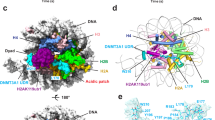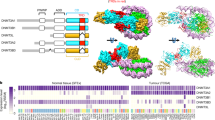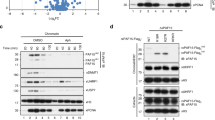Abstract
Epigenetic inheritance in mammals is characterized by high-fidelity replication of CpG methylation patterns during development1,2. UHRF1 (also known as ICBP90 in humans and Np95 in mouse)3 is an E3 ligase important for the maintenance of global and local DNA methylation in vivo4,5. The preferential affinity of UHRF1 for hemi-methylated DNA over symmetrically methylated DNA by means of its SET and RING-associated (SRA) domain6 and its association with the maintenance DNA methyltransferase 1 (DNMT1) suggests a role in replication of the epigenetic code4,5,7. Here we report the 1.7 Å crystal structure of the apo SRA domain of human UHRF1 and a 2.2 Å structure of its complex with hemi-methylated DNA, revealing a previously unknown reading mechanism for methylated CpG sites (mCpG). The SRA–DNA complex has several notable structural features including a binding pocket that accommodates the 5-methylcytosine that is flipped out of the duplex DNA. Two specialized loops reach through the resulting gap in the DNA from both the major and the minor grooves to read the other three bases of the CpG duplex. The major groove loop confers both specificity for the CpG dinucleotide and discrimination against methylation of deoxycytidine of the complementary strand. The structure, along with mutagenesis data, suggests how UHRF1 acts as a key factor for DNMT1 maintenance methylation through recognition of a fundamental unit of epigenetic inheritance, mCpG.
This is a preview of subscription content, access via your institution
Access options
Subscribe to this journal
Receive 51 print issues and online access
$199.00 per year
only $3.90 per issue
Buy this article
- Purchase on SpringerLink
- Instant access to full article PDF
Prices may be subject to local taxes which are calculated during checkout




Similar content being viewed by others
References
Holliday, R. & Pugh, J. E. DNA modification mechanisms and gene activity during development. Science 187, 226–232 (1975)
Razin, A. & Riggs, A. D. DNA methylation and gene function. Science 210, 604–610 (1980)
Unoki, M., Bronner, C. & Mousli, M. A concern regarding the current confusion with the human homolog of mouse Np95, ICBP90/UHRF1. Radiat. Res. 169, 240–244 (2008)
Sharif, J. et al. The SRA protein Np95 mediates epigenetic inheritance by recruiting Dnmt1 to methylated DNA. Nature 450, 908–912 (2007)
Bostick, M. et al. UHRF1 plays a role in maintaining DNA methylation in mammalian cells. Science 317, 1760–1764 (2007)
Unoki, M., Nishidate, T. & Nakamura, Y. ICBP90, an E2F-1 target, recruits HDAC1 and binds to methyl-CpG through its SRA domain. Oncogene 23, 7601–7610 (2004)
Achour, M. et al. The interaction of the SRA domain of ICBP90 with a novel domain of DNMT1 is involved in the regulation of VEGF gene expression. Oncogene 27, 2187–2197 (2008)
Yoder, J. A., Soman, N. S., Verdine, G. L. & Bestor, T. H. DNA (cytosine-5)-methyltransferases in mouse cells and tissues. Studies with a mechanism-based probe. J. Mol. Biol. 270, 385–395 (1997)
Ooi, S. K. & Bestor, T. H. Cytosine methylation: remaining faithful. Curr. Biol. 18, R174–R176 (2008)
Ho, K. L. et al. MeCP2 binding to DNA depends upon hydration at methyl-CpG. Mol. Cell 29, 525–531 (2008)
Roberts, R. J. On base flipping. Cell 82, 9–12 (1995)
Huffman, J. L., Sundheim, O. & Tainer, J. A. DNA base damage recognition and removal: new twists and grooves. Mutat. Res. 577, 55–76 (2005)
Cheng, X. & Blumenthal, R. M. Mammalian DNA methyltransferases: a structural perspective. Structure 16, 341–350 (2008)
Klimasauskas, S., Kumar, S., Roberts, R. J. & Cheng, X. HhaI methyltransferase flips its target base out of the DNA helix. Cell 76, 357–369 (1994)
Hoang, C. & Ferre-D’Amare, A. R. Cocrystal structure of a tRNA Psi55 pseudouridine synthase: nucleotide flipping by an RNA-modifying enzyme. Cell 107, 929–939 (2001)
Johnson, L. M. et al. The SRA methyl-cytosine-binding domain links DNA and histone methylation. Curr. Biol. 17, 379–384 (2007)
Karagianni, P., Amazit, L., Qin, J. & Wong, J. ICBP90, a novel methyl K9 H3 binding protein linking protein ubiquitination with heterochromatin formation. Mol. Cell. Biol. 28, 705–717 (2008)
Terwilliger, T. C. & Berendzen, J. Automated MAD and MIR structure solution. Acta Crystallogr. D 55, 849–861 (1999)
Terwilliger, T. C. Maximum-likelihood density modification using pattern recognition of structural motifs. Acta Crystallogr. D 57, 1755–1762 (2001)
Murshudov, G. N., Vagin, A. A. & Dodson, E. J. Refinement of macromolecular structures by the maximum-likelihood method. Acta Crystallogr. D 53, 240–255 (1997)
Emsley, P. & Cowtan, K. Coot: model-building tools for molecular graphics. Acta Crystallogr. D 60, 2126–2132 (2004)
Painter, J. & Merritt, E. A. TLSMD web server for the generation of multi-group TLS models. J. Appl. Crystallogr. 39, 109–111 (2006)
Acknowledgements
We thank F. Chedin, A. Edwards and R. Klose for discussions, and A. Dong for collecting data at the synchrotron. Diffraction data were measured at the Advanced Photon Source (Argonne, Illinois), which was supported by the US Department of Energy, Office of Science, Office of Basic Energy Sciences, under Contract no. DE-AC02-06CH11357. The Structural Genomics Consortium is a registered charity (number 1097737) that receives funds from the Canadian Institutes for Health Research, the Canadian Foundation for Innovation, Genome Canada through the Ontario Genomics Institute, GlaxoSmithKline, Karolinska Institutet, the Knut and Alice Wallenberg Foundation, the Ontario Innovation Trust, the Ontario Ministry for Research and Innovation, Merck & Co., Inc., the Novartis Research Foundation, the Swedish Agency for Innovation Systems, the Swedish Foundation for Strategic Research and the Wellcome Trust. This research was also supported by the Canadian Cancer Society (S.D. and C.H.A.).
Author Contributions S.D.-P., G.V.A., J.R.W., C.B. and C.H.A. developed the experimental design. S.D.-P. designed and S.D. and Y.L. prepared plasmids for bacterial expression of recombinant proteins. G.V.A. and S.X. performed purification, characterization and crystallization of proteins and EMSA. J.R.W. designed the oligonucleotides and conducted the structural analysis. S.D.-P., C.H.A., J.R.W. and G.V.A. interpreted results and wrote the manuscript.
Author information
Authors and Affiliations
Corresponding author
Supplementary information
Supplementary Information
This file contains Supplementary Tables 1-2, Supplementary Figures 1-6 and a Supplementary Reference. (PDF 653 kb)
Rights and permissions
About this article
Cite this article
Avvakumov, G., Walker, J., Xue, S. et al. Structural basis for recognition of hemi-methylated DNA by the SRA domain of human UHRF1. Nature 455, 822–825 (2008). https://doi.org/10.1038/nature07273
Received:
Accepted:
Published:
Issue Date:
DOI: https://doi.org/10.1038/nature07273
This article is cited by
-
MBD4 loss results in global reactivation of promoters and retroelements with low methylated CpG density
Journal of Experimental & Clinical Cancer Research (2023)
-
PLK1 maintains DNA methylation and cell viability by regulating phosphorylation-dependent UHRF1 protein stability
Cell Death Discovery (2023)
-
Dppa3 facilitates self-renewal of embryonic stem cells by stabilization of pluripotent factors
Stem Cell Research & Therapy (2022)
-
Mechanisms of chromatin-based epigenetic inheritance
Science China Life Sciences (2022)
-
Regulatory mechanism and biological function of UHRF1–DNMT1-mediated DNA methylation
Functional & Integrative Genomics (2022)



